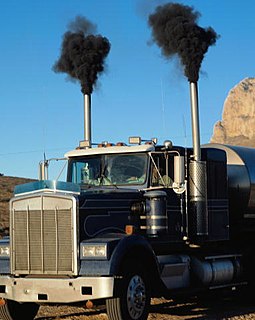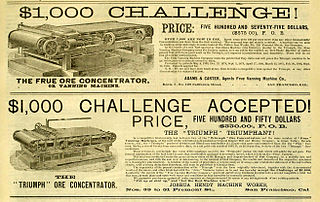Related Research Articles
In economics, a free market is a system in which the prices for goods and services are self-regulated by buyers and sellers negotiating in an open market. In a free market, the laws and forces of supply and demand are free from any intervention by a government or other authority, and from all forms of economic privilege, monopolies and artificial scarcities. Proponents of the concept of free market contrast it with a regulated market in which a government intervenes in supply and demand through various methods such as tariffs used to restrict trade and to protect the local economy. In an idealized free-market economy, also called a liberal market economy, prices for goods and services are set freely by the forces of supply and demand and are allowed to reach their point of equilibrium without intervention by government policy.

Microeconomics is a branch of mainstream economics that studies the behavior of individuals and firms in making decisions regarding the allocation of scarce resources and the interactions among these individuals and firms. Microeconomics focuses on the study of individual markets, sectors, or industries as opposed to the national economy as whole, which is studied in macroeconomics.
In economics, specifically general equilibrium theory, a perfect market, also known as an atomistic market, is defined by several idealizing conditions, collectively called perfect competition, or atomistic competition. In theoretical models where conditions of perfect competition hold, it has been demonstrated that a market will reach an equilibrium in which the quantity supplied for every product or service, including labor, equals the quantity demanded at the current price. This equilibrium would be a Pareto optimum.
Pareto efficiency or Pareto optimality is a situation where no individual or preference criterion can be better off without making at least one individual or preference criterion worse off or without any loss thereof. The concept is named after Vilfredo Pareto (1848–1923), Italian civil engineer and economist, who used the concept in his studies of economic efficiency and income distribution. The following three concepts are closely related:

In economics, an externality is an indirect cost or benefit to an uninvolved third party that arises as an effect of another party's activity. Externalities can be considered as unpriced goods involved in either consumer or producer market transactions. Air pollution from motor vehicles is one example. The cost of air pollution to society is not paid by either the producers or users of motorized transport to the rest of society. Water pollution from mills and factories is another example. We are all made worse off by pollution but are not compensated by the market for this damage. A positive externality is when an individual's consumption in a market increases the well being of others, but the individual does not charge the third party for the benefit. The third party is essentially getting a free product. An example of this might be the apartment above a bakery receiving the benefit of enjoyment from smelling fresh pastries every morning. The people who live in the apartment do not compensate the bakery for this benefit.

In neoclassical economics, market failure is a situation in which the allocation of goods and services by a free market is not Pareto efficient, often leading to a net loss of economic value. Market failures can be viewed as scenarios where individuals' pursuit of pure self-interest leads to results that are not efficient– that can be improved upon from the societal point of view. The first known use of the term by economists was in 1958, but the concept has been traced back to the Victorian philosopher Henry Sidgwick. Market failures are often associated with public goods, time-inconsistent preferences, information asymmetries, non-competitive markets, principal–agent problems, or externalities.
In microeconomics, economic efficiency is, roughly speaking, a situation in which nothing can be improved without something else being hurt. Depending on the context, it is usually one of the following two related concepts:
A Pigovian tax is a tax on any market activity that generates negative externalities. The tax is normally set by the government to correct an undesirable or inefficient market outcome, and does so by being set equal to the external marginal cost of the negative externalities. In the presence of negative externalities, social cost includes private cost and external cost. This means the social cost of a market activity is not covered by the private cost of the activity. In such a case, the market outcome is not efficient and may lead to over-consumption of the product. Often-cited examples of such negative externalities are environmental pollution, and increased public healthcare costs associated with tobacco and sugary drink consumption.
Social cost in neoclassical economics is the sum of the private costs resulting from a transaction and the costs imposed on the consumers as a consequence of being exposed to the transaction for which they are not compensated or charged. In other words, it is the sum of private and external costs. This might be applied to any number of economic problems: for example, social cost of carbon has been explored to better understand the costs of carbon emissions for proposed economic solutions such as a carbon tax.
Welfare economics is a branch of economics that uses microeconomic techniques to evaluate well-being (welfare) at the aggregate (economy-wide) level.
Allocative efficiency is a state of the economy in which production is aligned with consumer preferences; in particular, every good or service is produced up to the point where the last unit provides a marginal benefit to consumers equal to the marginal cost of producing.
A theory of capitalism describes the essential features of capitalism and how it functions. The history of various such theories is the subject of this article.
Government failure, in the context of public economics, is an economic inefficiency caused by a government intervention, if the inefficiency would not exist in a true free market. It can be viewed in contrast to a market failure, which is an economic inefficiency that results from the free market itself, and can potentially be corrected through government regulation. The idea of government failure is associated with the policy argument that, even if particular markets may not meet the standard conditions of perfect competition required to ensure social optimality, government intervention may make matters worse rather than better.
Arnold Carl Harberger is an American economist. His approach to the teaching and practice of economics is to emphasize the use of analytical tools that are directly applicable to real-world issues. His influence on academic economics is reflected in part by the widespread use of the term "Harberger triangle" to refer to the standard graphical depiction of the efficiency cost of distortions of competitive equilibrium. His influence on the practice of economic policy is manifested by the high positions attained in national agencies such as central banks and ministries of finance, and in international agencies such as the World Bank.

In economics, competition is a scenario where different economic firms are in contention to obtain goods that are limited by varying the elements of the marketing mix: price, product, promotion and place. In classical economic thought, competition causes commercial firms to develop new products, services and technologies, which would give consumers greater selection and better products. The greater the selection of a good is in the market, prices are typically lower for the products, compared to what the price would be if there was no competition (monopoly) or little competition (oligopoly). According to Antoine Augustin Cournot, the definition of competition is the situation in which price does not vary with quantity, or in which the demand curve facing the firm is horizontal. The level of competition that exists within the market is dependent on a variety of factors both on the firm/ seller side; the number of firms, barriers to entry, information, and availability/ accessibility of resources. The number of buyers within the market also factors into competition with each buyer having a willingness to pay, influencing overall demand for the product in the market.
Richard George Lipsey, is a Canadian academic and economist. He is best known for his work on the economics of the second-best, a theory that demonstrated that piecemeal establishing of individual first best conditions would not necessarily raise welfare in a situation in which all first best conditions could not be satisfied, an article that he co-authored with Kelvin Lancaster, a mathematical economist of high standing. He is currently Professor Emeritus of Economics at Simon Fraser University.

Peter Arthur Diamond is an American economist known for his analysis of U.S. Social Security policy and his work as an advisor to the Advisory Council on Social Security in the late 1980s and 1990s. He was awarded the Nobel Memorial Prize in Economic Sciences in 2010, along with Dale T. Mortensen and Christopher A. Pissarides. He is an Institute Professor at the Massachusetts Institute of Technology. On June 6, 2011, he withdrew his nomination to serve on the Federal Reserve's board of governors, citing intractable Republican opposition for 14 months.
In neoclassical economics, a market distortion is any event in which a market reaches a market clearing price for an item that is substantially different from the price that a market would achieve while operating under conditions of perfect competition and state enforcement of legal contracts and the ownership of private property. A distortion is "any departure from the ideal of perfect competition that therefore interferes with economic agents maximizing social welfare when they maximize their own". A proportional wage-income tax, for instance, is distortionary, whereas a lump-sum tax is not. In a competitive equilibrium, a proportional wage income tax discourages work.
Optimal tax theory or the theory of optimal taxation is the study of designing and implementing a tax that maximises a social welfare function subject to economic constraints. The social welfare function used is typically a function of individuals' utilities, most commonly some form of utilitarian function, so the tax system is chosen to maximise the aggregate of individual utilities. Tax revenue is required to fund the provision of public goods and other government services, as well as for redistribution from rich to poor individuals. However, most taxes distort individual behavior, because the activity that is taxed becomes relatively less desirable; for instance, taxes on labour income reduce the incentive to work. The optimization problem involves minimizing the distortions caused by taxation, while achieving desired levels of redistribution and revenue. Some taxes are thought to be less distorting, such as lump-sum taxes and Pigouvian taxes, where the market consumption of a good is inefficient and a tax brings consumption closer to the efficient level.
An economic profit is the difference between the revenue a commercial entity has received from its outputs and the opportunity costs of its inputs. Unlike an accounting profit, an economic profit takes into account both a firm's implicit and explicit costs, whereas an accounting profit only relates to the explicit costs which appear on a firm's financial statements. Because it includes additional implicit costs, the economic profit usually differs from the accounting profit.
References
- ↑ Heath, Joseph (2009). Filthy lucre : economics for people who hate capitalism. Toronto: HarperCollins. ISBN 978-1-55468-769-5. OCLC 615371821.
- ↑ Lipsey, R. G.; Lancaster, Kelvin (1956). "The General Theory of Second Best". Review of Economic Studies . 24 (1): 11–32. doi:10.2307/2296233. JSTOR 2296233.
- ↑ Krugman, Paul (June 22, 2014). "The Big Green Test - Conservatives and Climate Change". The New York Times . Retrieved 27 June 2014.
- ↑ "Making the second best of it". Free Exchange. Economist. August 21, 2007. Retrieved 27 June 2014.